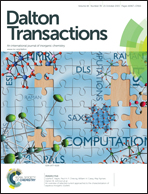Aromatic hydroxylation using an oxo-bridged diiron(iii) complex: a bio-inspired functional model of toluene monooxygenases†
Abstract
In biology, aromatic hydroxylation is carried out using a family of heme and nonheme oxygenases, such as cytochrome P450, toluene monooxygenases (TMOs), and methane monooxygenase (MMO). In contrast, a vast majority of synthetic iron based catalysts employed so far in aromatic hydroxylation are monomeric in nature. Herein, we have employed a diferric complex of an aminopyridine ligand ([(bpmen)2Fe2O(μ-O)(μ-OH)](ClO4)3 (2), bpmen = N,N′-dimethyl-N,N′-bis(2-pyridylmethyl)-1,2-diaminoethane) towards aromatic hydroxylation with H2O2 and acetic acid. The diiron(III) complex shows promising reactivity in the hydroxylation of benzene and alkylbenzenes with a higher selectivity towards aromatic ring hydroxylation over alkyl chain oxidation. The μ-oxo diiron(III) core has been shown to be regenerated at the end of catalytic turnover. However, mechanistic studies indicate that the diiron(III) complex undergoes dissociation into its monomeric congener and the resulting iron(III) complex mitigates aromatic hydroxylation.


 Please wait while we load your content...
Please wait while we load your content...